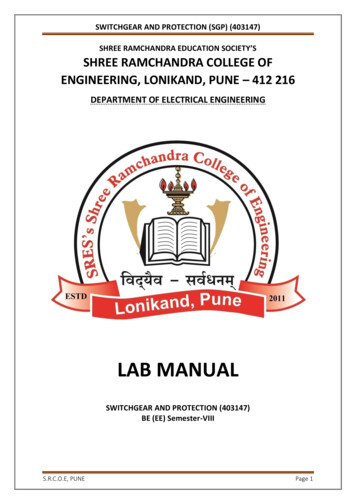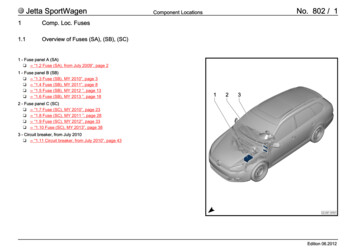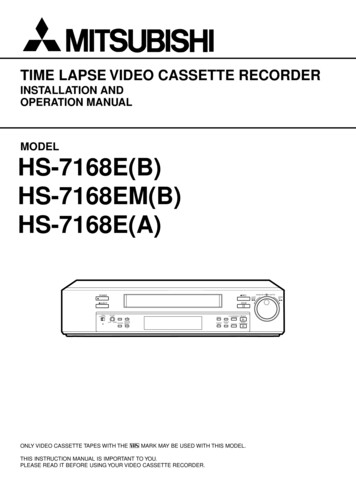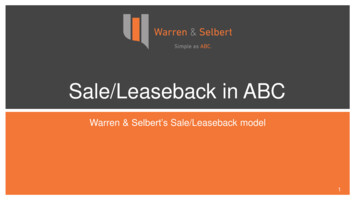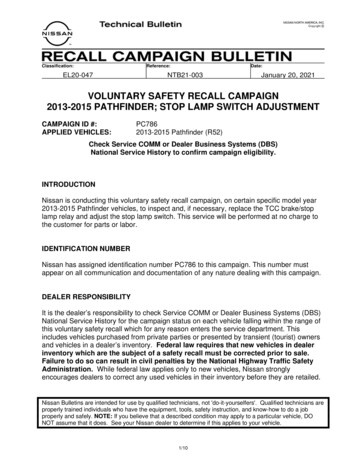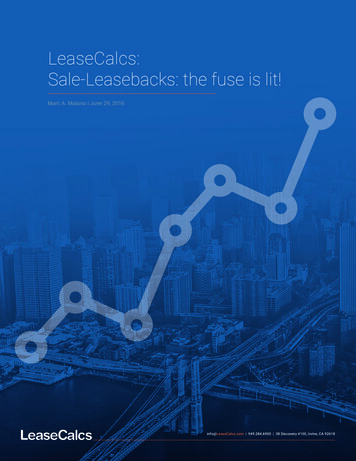
Transcription
LeaseCalcs:Sale-Leasebacks: the fuse is lit!Marc A. Maiona June 29, 2016info@LeaseCalcs.com 949.284.6900 38 Discovery #100, Irvine, CA 92618
Sale-Leasebacks: TheFASB & IASB just lit thefuse on SLBs!It’s not just about the “leaseback” coming onto thebalance sheet – the treatment of the gain on salewill reduce the appeal of SLBs going forward.Any company currently owning real estate that isOverview of current SLB accounting.used in its business operations, such as a corporateUnder current lease accounting standards, aheadquarters, manufacturing facility, distributioncompany entering into a SLB transaction willcenter or the like, that has either been highlyessentially account for the transaction as one eventdepreciated or has seen significant appreciation, iswith two related parts; the sale and the leaseback.well advised to pay close attention to the impact ofIn terms of the big picture of what happens on thethe FASB’s and IASB’s changes to sale-leasebackfinancial statement, there are cash, balance sheetaccounting. If a company were ever to contemplateand P&L impacts, as follows:executing a sale-leaseback (“SLB”), it will be much The sale of the property removes the net bookmore advantageous, from a financial reportingvalue of the building, along with the land value,perspective, to have completed the transactionfrom the balance sheet and replaces it withbefore the new rules become effective.cash in the amount of the net sales proceeds.The building and land values were classifiedWhat many observers have overlooked is theas “fixed assets” while the cash received is afact the new lease accounting standards did not“current asset”. Since in most cases the cashjust create a sea change in the way leases areproceeds exceeds the net book value of theaccounted for, they also created an even biggerproperty sold, this is beneficial to the balancechange to the way the gains (or losses) on anysheet both in terms of total assets and liquidity.SLB are accounted for under the new standards. Under current lease accounting standardsTo help explain the impact of this new world ofnearly all SLBs have been structured in suchSLB accounting a quick review of the way currenta way to result in the “leaseback” portion ofstandards work may prove helpful.the deal to be classified as an operating lease(whether under ASC840 or IAS17), in order toinfo@LeaseCalcs.com 949.284.6900 38 Discovery #100, Irvine, CA 92618
have the leaseback treated as an off-balanceThe New Rules Change The Sale Treatment, Notsheet transaction.Just the Leaseback Immediately following the closing of theIn short, about the only thing the new accountingtransaction, the former owner and now tenantstandards did not manage to change with SLBwould report straight line rent expense ontransactions was the removal of the fixed assetthe P&L, but in an annual amount arguablyfrom the balance sheet in exchange for the cashhigher – and potentially much higher – thanproceeds. Virtually everything else has changed,the depreciation expense that would have beenand for many companies those changes are not forreported had it continued to own the property.the better. The gain (or potentially the loss), the companywould realize on the sale of the propertyMost people who have followed the FASB’s andwould – from a GAAP or IFRS reportingIASB’s work on the new standards have rightlyperspective – then be deferred on a straightfocused on the “lease” in “lease accounting”. Asline basis over the leaseback period.1 This issuch, it is fairly widely known under the new rules allone of the hallmarks of SLB transactions underleases will be capitalized onto the lessee’s balancecurrent standards, and is a critically importantsheet, with a corresponding “Right of Use Asset”feature as the deferral of the gain that runsand “Lease Liability”. Without getting into thethrough the P&L over the leaseback perioddetails of how those values are calculated (that’sserves to offset the notable increase in P&La subject for another article), suffice it to say theexpense resulting from the replacement of oldleaseback in every SLB is now on a roundtrip – itdepreciation expense with new straight lineis coming right back onto the balance sheet, withrent expense.impacts to shareholder equity, return on assetsand, in certain cases (all cases for IFRS reportingAside from the ability to monetize the value ofcompanies), debt levels and related ratios.2an asset to reinvest in the business, one of thegreatest advantages of SLBs from a financialMore critically, however, because of the way inreporting perspective is the deferral of the gainwhich the new lease accounting standards interactthat results from the sale. This is due to the factwith another set of new accounting rules knownthe deferral means the company does not haveas “Revenue Recognition”3 , SLBs under the newto explain a large one-time gain on its P&L and,accounting regimes will be treated as two separateperhaps more importantly, can use the deferral oftransactions: one being the sale and the otherthe gain to “soak up” much, if not all, of the increasebeing the leaseback. It is this separation of thein expenses running through the P&L as a resulttransaction into two distinct parts that dramaticallyof trading relatively low depreciation expense foralters the P&L treatment going forward.higher straight line rent expense.info@LeaseCalcs.com 949.284.6900 38 Discovery #100, Irvine, CA 92618
No More Deferred Gains On SLBs After New Rules Take EffectBecause the new accounting rules treat the “sale” separately from the “leaseback”, going forward there willbe no deferral of any gain (or loss) recognized on the sale of a building into a SLB transaction. Rather, all ofthe gain will be recognized immediately. The impact of this change means for SLBs transacted after the newrules take effect the entirety of the gain will be recognized in the P&L the day the sale closes and the expenserunning through the P&L will be significantly greater than what the depreciation expense would have been hadthe company continued to own the building. For many companies this one-time “spike” in earnings and thepermanent increase in the expense profile on the P&L during the leaseback period will very likely cause theSLB to be untenable from a P&L perspective.The excerpt of LeaseCalcs’ report below illustrates one such example, where the seller / lessee completes aSLB after the new standards take effect and where the leaseback is classified as a “Type B” / operating leaseunder the new accounting standards. The result of which is the entirety of the gain is booked on the day thesale closes and the annual expense profile is materially greater than it would have been if the company hadcontinued to own the building.Deferred Gains On Existing Operating Leases Cease, Too!One of the most overlooked aspects of these accounting standards is not that there is no grandfathering forexisting leases having to be brought onto the balance sheet. That has been well publicized. Rather, it is thatfor any pre-existing SLB where the leaseback was classified as an operating lease, any as-yet-unrecognizeddeferred gains will never provide any benefit to the company’s P&L once the new standards become effective.Instead, the amount of the unrecognized gain being carried on the firm’s balance sheet will bypass the P&Lentirely on the effective date of the new rules and drop to retained earnings. In other words, any companythat has already completed a SLB – or any company currently contemplating a SLB – had better understandthe impact of that transaction on the P&L once the new standards take effect. Many companies are in for anunpleasant surprise.The example below illustrates a company that completed its SLB before the change in accounting standardswould have received the benefit of the deferred gain treatment for a few years, but then all of the remainingunrecognized gain dropped to retained earnings on the date the new accounting standards take effect.info@LeaseCalcs.com 949.284.6900 38 Discovery #100, Irvine, CA 92618
Notably, there is a material increasein the P&L expense profile once thedeferral ceases.The One Silver LiningWhile the new accounting standards mean companies – and their advisors – will need to look at SLBs in anentirely different light in order to maximize the financial statement benefits of these transactions, there isone silver lining – or opportunity – in the new standards. Nearly all SLBs have historically been structured toqualify for operating lease treatment, largely because companies did not want the leaseback showing up on thebalance sheet. However, they do not need to be structured that way, particularly considering the leaseback willbe making a roundtrip back onto the balance sheet under the new standards. But why would a company wantto structure a leaseback as a capital lease under existing standards? Because that is where the one silver liningexists, and, besides, all leases are being capitalized onto the balance sheet anyway.In the course of finalizing the new lease accounting standards the FASB and IASB decided any as-yetunrecognized gains related only to SLBs where the leaseback was a capital lease under current standards,would continue to be deferred after the effective date of the new rules. In other words, for a company enteringinto a SLB today and structuring the leaseback as a capital lease, the deferral of the gain is grandfathered! Theillustration below represents this scenario.info@LeaseCalcs.com 949.284.6900 38 Discovery #100, Irvine, CA 92618
The Opportunity: For companies lookingto monetize highly depreciated or highlyappreciated assets by way of a SLB, aviable option still exists that serves toprotect the P&L.But only for a short time, as the FASB and IASB have effectively lit a fuse on SLB transactions4. Some finalthings to consider before you rush complete a transaction: To achieve capital lease classification under current lease accounting the leaseback will have to beevaluated under existing capital vs. operating lease rules. Generally speaking, to achieve capital lease treatment usually requires a longer term lease – sayupwards of or longer than 20 years. This in turn, however, should increase the sales proceeds and theresulting gain. Structuring a leaseback with “above market” or “below market” lease terms has accountingconsequences, so be mindful of this in relation to the gain you expect to be able to defer. A company that only does a leaseback for a portion of the building will have to recognize some of thegain – i.e., not defer that portion – immediately, and leasing back too small of a portion of the buildingcan result in all of the gain being recognized immediately.Also, should a company wait to complete a SLB until after the new accounting standards take effect there aretwo other important considerations under the new rules: A SLB involving real estate cannot provide the seller / lessee with an option to reacquire the building,even at fair market value. Doing so will result in the transaction being accounted for as a financing ofthe building rather than a sale and leaseback. Under US-GAAPs new rules, the leaseback on a SLB entered into after the new standards take effectcannot be classified as a “Type A” / Finance lease, otherwise it, too, will be accounted for as a financingof the building rather than a sale and leaseback.Finally, if you are not already subscribed to LeaseCalcs and need more information on how a SLB transactionmight affect your – or your client’s – financials, please reach out to schedule a demo or to speak with one ofour experts. 949.284.6900 or info@LeaseCalcs.cominfo@LeaseCalcs.com 949.284.6900 38 Discovery #100, Irvine, CA 92618
1There are certain exceptions to this deferral treatment, most notably where thetenant does not leaseback 100% of the property or when the gain exceeds thepresent value of the rent payments over the leaseback period.2Any lease classified as a “Type A” (more recently referred to as a “FinanceLease”) under the new standards – which will include all leases under the newIFRS standards – will have its associated liability technically classified as debton the lessee’s balance sheet.3Refer to Accounting Standards Update No. 2014-09 from FASB and IFRS 15from the IASB.4This is not to say the entire SLB market will go away after the new standardstake effect. Some companies will still find the asset monetization aspects ofSLBs outweigh the GAAP / IFRS reporting aspects, though we expect those tobe fewer in number.info@LeaseCalcs.com 949.284.6900 38 Discovery #100, Irvine, CA 92618
the FASB's and IASB's changes to sale-leaseback accounting. If a company were ever to contemplate executing a sale-leaseback ("SLB"), it will be much more advantageous, from a financial reporting perspective, to have completed the transaction before the new rules become effective. What many observers have overlooked is the


